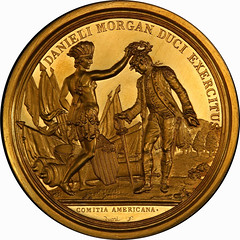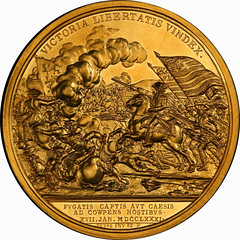
PREV ARTICLE
NEXT ARTICLE
FULL ISSUE
PREV FULL ISSUE
V25 2022 INDEX E-SYLUM ARCHIVE GOLD DANIEL MORGAN COMITIA AMERICANA MEDALLast week we got a hint of an amazing discovery being offered by Stack's Bowers in their Spring 2022 sales - the only gold Comitia Americana medal in private hands. Cataloguer John Kralvevich Jr. kindly provided a copy of his lengthy lot description. With permission, here is an excerpt. -Editor When a national treasure from the American Revolution was stolen in a brazen bank heist in 1818, a dutiful heir involved former President Thomas Jefferson and lobbied for an Act of Congress to replace it. This is the medal his decades of persistence achieved, the only example struck, the only gold Comitia Americana medal in private hands, and the only Congressional Gold Medal ever authorized by two separate Acts of Congress. Struck at the Philadelphia Mint in 1839 from dies fashioned in Paris, it is utterly unique. It is offered, here, at auction for the very first time, a majestic testament in gold to the debt owed this nation's first military heroes and the efforts to honor their legacy. Struck in impressive relief and superlative detail, this medal is the finest medallic effort of its age and, perhaps, any other, taken from Dupre's original work from 1789. The devices stand in bold contrast to the deeply reflective fields on both sides, rising from the richest yellow gold. The Philadelphia Mint struck few gold medals in this era (this was the largest since the 1837 striking of the Col. George Croghan medal for the Battle of Sandusky), and special care was clearly taken in preparing its planchet and executing its striking. The centering is precise, and the details were raised by two exacting strikes, right atop each other but visible on both sides. The dies were fresh and in their earliest die state, as expected, as the dies were produced for just one purpose: to coin this exact medal. Fine preparatory finishing and file marks in the die are seen on the border between the interior and exterior rim. Microscopic hints of spalling (sometimes incorrectly called die rust) are seen in the obverse exergue. A few lintmarks are seen, indicating the polishing of the dies prior to striking. The largest of them is between the tops of LI of DANIELI, but the most interesting of them appears on the edge. It takes a special medal to make sure the die faces are polished and clean, but it takes another order of magnitude to similarly prepare the collar to produce a bright and lustrous edge. The beautiful original case, seen on other unique gold medals from this era (like the one made for Adam Eckfeldt in 1839), served its function perfectly. It not only presented this medal a dramatic backdrop fit for its historic stature, but preserved it well. The surfaces are watery, lustrous, bright, and free of contact marks. The edges are perfect and unflawed, and the devices show no evidence of wear.
Initially authorized in March 1781, just two months after the epochal battle in the upcountry of
South Carolina, the Morgan at Cowpens medal was among the medal projects left incomplete
by both Benjamin Franklin and David Humphreys as they came, and went, from Paris. Upon
Humphreys' departure in 1786, the as-yet-unfinished medals authorized by Congress became
the sole responsibility of Minister Plenipotentiary to France, Thomas Jefferson, assisted by his
secretary, William Short. Thomas Jefferson, recalled to the United States to serve as President George Washington's first Secretary of State, carried the gold medal for Gen. Daniel Morgan with him upon his return from Paris in September 1789. On March 25, 1790, Washington transmitted the glittering gold medal to Morgan, then living near the frontier town of Winchester, Virginia. Upon his death in 1802, it was carried to Pittsburgh by his widow and placed in the care of his son-in-law, Col. Presley Neville. Neville married Daniel Morgan's oldest daughter, Nancy, in 1782. They had 14 children, of whom Morgan Lafayette Neville was the oldest, born in 1783.
Morgan Neville and Pittsburgh's First Bank Robbery
Neville was the cashier of Pittsburgh's Farmers and Mechanics Bank when disaster struck on
April 6, 1818. The bank was burglarized in the middle of the night Neville's entire patrimony and life savings was gone. His bank closed down, unable to do business. Morgan's gold medal was foremost among the relics left to his young namesake, an item of importance to both his family and the nation, and an object of great value too. Neville's bank offered a huge reward for the return of what was stolen: first $1000, then $3000 for the loot and $1000 for the capture of those responsible. The medal was never recovered. Morgan Neville steadfastly lobbied Congress for a replacement for the lost medal, a request that was ultimately granted, but it took years more to have it struck. -Editor Morgan Neville died on March 2, 1839. He never saw the medal. His lifelong quest for absolution in losing the ultimate family heirloom ended unrequited. But his legacy carried on: through his namesake son and proud string of descendants, through his written works, and through his long-lasting reputation as one of the founders of American pioneer fiction. Secretary of War John Bell, after some delay pondering the medal's rightful owner, presented the renewed Daniel Morgan at Cowpens medal to Neville's son, Morgan Lafayette Neville, Jr., on September 11, 1841. Upon his death in 1855, the medal passed to his son Jesse, then just a child. Perhaps because he grew up without his father, Jesse Neville cherished the medal. He even put it on display in a jewelry store window in Saratoga, New York, his summer vacation destination, in August 1885. At some point after 1914, the medal passed out of the family. According to the history of this medal given to us, it was acquired from a descendent of J. Pierpont Morgan, Jr. Morgan, the wealthy banker and heir to both his father's fortune and philanthropic sensibilities, formed immense collections, many of which have since become part of the Metropolitan Museum of Art. Morgan, we are told, acquired the medal in the hopes that Daniel Morgan was an ancestor, but upon discovering no familial connection, decided it was no longer appropriate for the family holdings. Stack's Bowers Galleries has been fortunate to set the world record for American historical medals with unique Congressional Gold Medals on two occasions. First, in 2006, Gen. Zachary Taylor's 1848 Congressional Gold Medal awarded for the Battle of Buena Vista in the Mexican- American War brought $460,000. It was the first Congressional Gold Medal to cross the $100,000 barrier, and the highest realization for a Congressional Gold Medal since Anthony Wayne's medal for the 1779 Battle of Stony Point brought $51,000 in a 1978 Sotheby Parke- Bernet sale. More recently, in August 2021, the Congressional Gold Medal awarded to Gen. William Henry Harrison for the 1813 Battle of the Thames brought $600,000 at public auction, setting a new high-water mark for a Congressional Gold Medal. The only silver Paris Mint Daniel Morgan at Cowpens medal in private hands brought $115,000 in our November 2019 sale of the John W. Adams Collection. It had once been the world record holder for an American historical medal, bringing $80,500 in May 2001. Four Paris strikes of the Morgan medal in copper remain in private hands. Two of those medals were included in the Adams Collection, bringing $55,200 and $78,000. The Adams Collection included no silver strikes from the 1839 Morgan dies (or this unique gold strike, of course), but a silver strike from these dies in our November 2021 sale brought $33,600. What an amazing numismatic treasure, with a fascinating backstory. Way back in 2003, John spoke at the annual banquet of the Pennsylvania Association of Numismatists about the original medal, the bank robbery, and the mystery of the missing replacement medal, which hadn't been seen or heard of since that 1885 display. And here we are in 2020, and the medal ended up with John to catalog. What a great treat! -Editor John adds: "I had no idea the medal struck by Act of Congress to replace the one tossed into the Ohio by the thieves would ever turn up, let alone end up on my desk. "This is absolutely the coolest out-of-the-woodwork medal I've ever gotten to handle."
To read the earlier E-Sylum article, see:
Wayne Homren, Editor The Numismatic Bibliomania Society is a non-profit organization promoting numismatic literature. See our web site at coinbooks.org. To submit items for publication in The E-Sylum, write to the Editor at this address: whomren@gmail.com To subscribe go to: https://my.binhost.com/lists/listinfo/esylum All Rights Reserved. NBS Home Page Contact the NBS webmaster 
|




